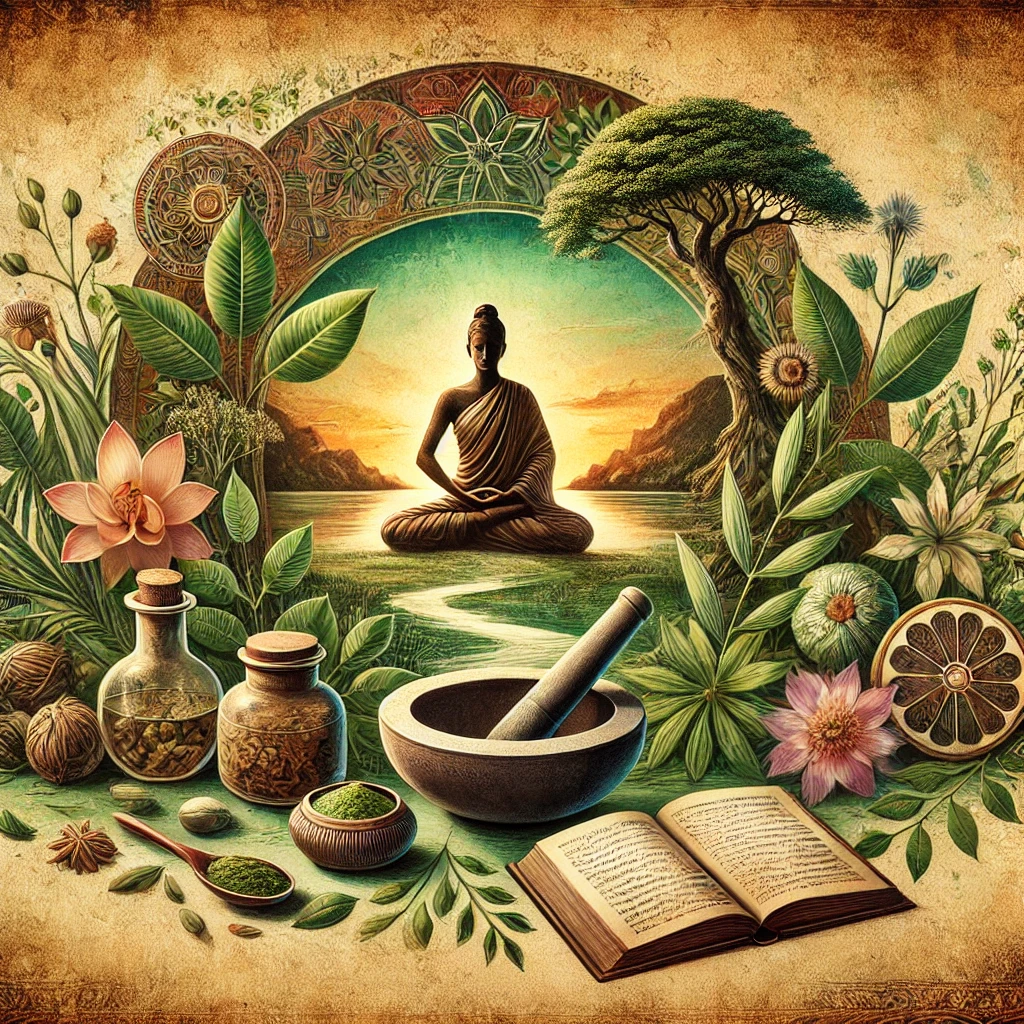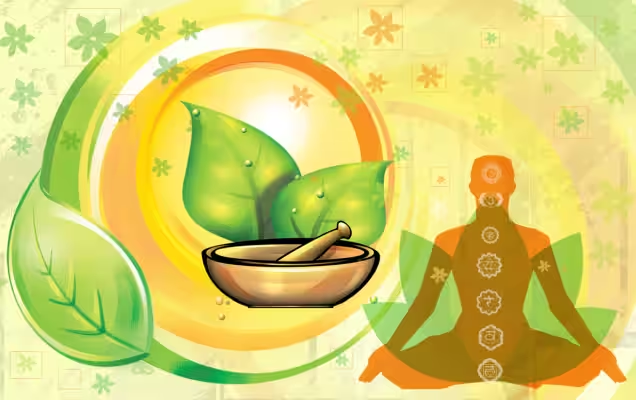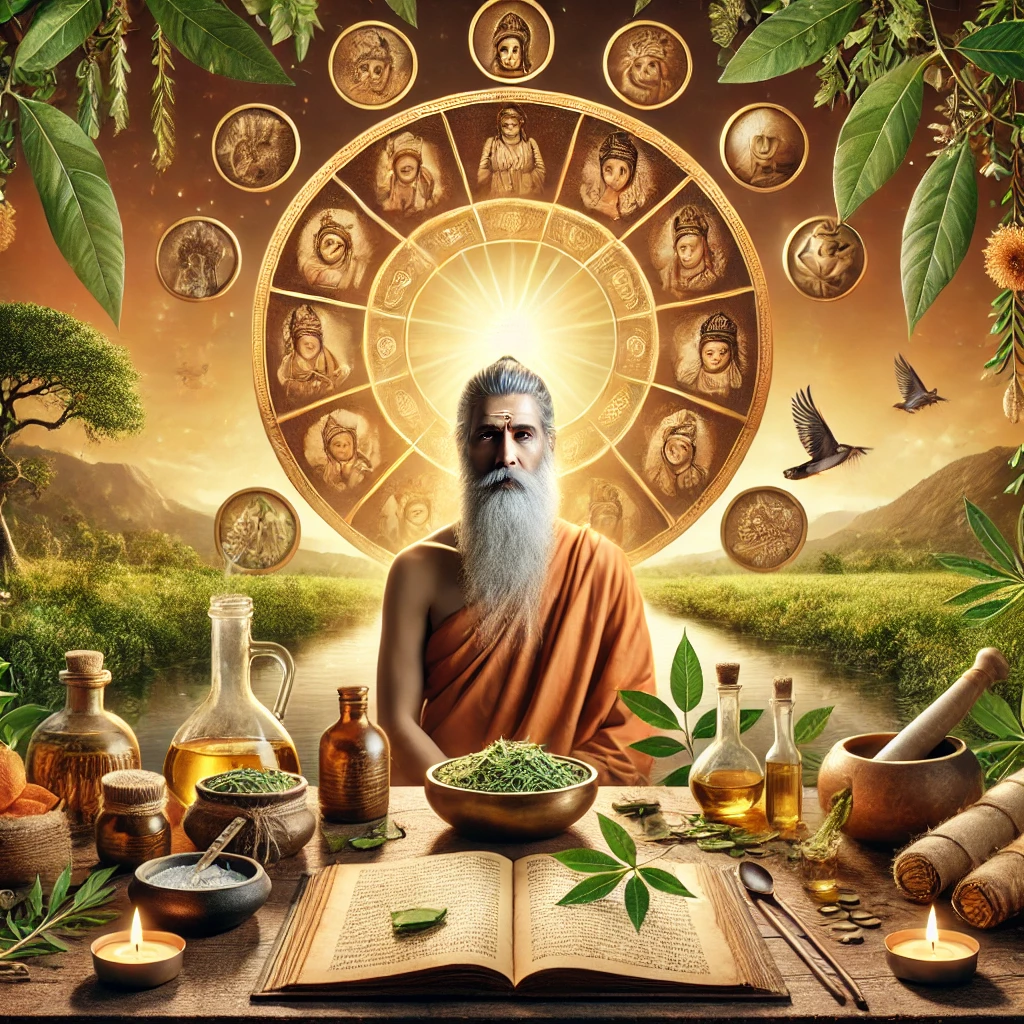Table of Contents
INTRODUCTION
In today’s fast-paced world, where stress, unhealthy eating habits, and a sedentary lifestyle dominate, Ayurveda emerges as a beacon of natural healing and wellness. Ayurveda, often referred to as the “science of life,” is a holistic system of medicine that originated in India over 5,000 years ago.
Rooted in the principles of balance, Ayurveda focuses on harmonizing the mind, body, and spirit to achieve optimal health.
Ayurveda is not merely a system of medicine but a way of life that integrates natural remedies, mindful living, and personalized health practices. This ancient wisdom has gained global recognition for its effectiveness in promoting longevity, preventing diseases, and restoring vitality.
Unlike conventional medicine, which often treats symptoms, Ayurveda focuses on identifying the root cause of ailments and addressing them through a combination of diet, herbal treatments, yoga, and lifestyle changes.
This blog explores Ayurveda’s principles, benefits, and practical applications in modern life. Whether you are new to Ayurveda or looking to deepen your understanding, this comprehensive guide will provide you with insights on how to integrate Ayurveda into your daily routine for a healthier and more balanced life.
Understanding Ayurveda
Definition and Meaning
The word Ayurveda is derived from Sanskrit, where “Ayur” means life and “Veda” means knowledge or science. Thus, Ayurveda translates to “the science of life.” It is one of the world’s oldest holistic healing systems, developed to promote overall well-being rather than merely curing diseases.
Ayurveda emphasizes prevention over cure and believes in treating each person as a unique individual. The philosophy of Ayurveda revolves around the idea that health and wellness depend on the delicate balance between the mind, body, and spirit.
By aligning oneself with nature’s rhythms and adopting Ayurvedic principles, one can achieve long-term health benefits.

The Three Doshas: Vata, Pitta, and Kapha
Ayurveda operates on the concept of the three doshas—biological energies that govern the human body. These doshas are responsible for various physiological and psychological functions and play a vital role in determining an individual’s health and well-being.
- Vata (Air & Ether) – Controls movement, circulation, nerve impulses, and creativity. An imbalance may lead to anxiety, insomnia, dry skin, and digestive issues. People with a predominant Vata constitution tend to be energetic, enthusiastic, and quick-thinking but can become restless and scattered if out of balance.
- Pitta (Fire & Water) – Governs metabolism, digestion, body temperature, and intelligence. Excess Pitta can cause acidity, inflammation, skin issues, and irritability. Pitta individuals are often strong-willed, ambitious, and competitive, but an imbalance can lead to aggression and burnout.
- Kapha (Earth & Water) – Regulates structure, immunity, strength, and stability. Imbalance can result in weight gain, sluggishness, congestion, and emotional lethargy. Kapha-dominant individuals tend to be calm, loyal, and nurturing but may struggle with motivation and inertia when out of balance.
Each individual has a unique constitution, or Prakriti, which is a combination of these doshas. Ayurveda focuses on maintaining their equilibrium for overall health.
Understanding one’s dosha type allows for personalized health recommendations, including diet, exercise, and lifestyle choices tailored to individual needs.

Key Components of Ayurveda
1. Ayurvedic Diet and Nutrition
An Ayurvedic diet is a cornerstone of holistic wellness. It emphasizes eating according to one’s dosha type and seasonal variations. Ayurvedic dietary principles focus on fresh, whole foods, proper food combinations, and mindful eating practices.
- Vata Diet – Since Vata is light, dry, and cold, warm, moist, and grounding foods like soups, stews, cooked grains, nuts, and dairy help balance its dryness. Avoid raw, cold, and dry foods like crackers and salads, which can aggravate Vata.
- Pitta Diet – Cooling foods such as cucumbers, leafy greens, melons, and coconut reduce Pitta’s heat. Avoid spicy, oily, and fermented foods, as they can increase Pitta’s fiery nature.
- Kapha Diet – Light, dry, and warming foods like lentils, bitter greens, and spices (ginger, turmeric, black pepper) prevent sluggishness. Avoid heavy, oily, and dairy-rich foods that can increase Kapha’s tendency toward weight gain.
Eating mindfully—chewing food properly, avoiding distractions while eating, and eating at regular intervals—ensures optimal digestion and absorption of nutrients.

2. Herbal Remedies and Supplements
Herbal supplements play a vital role in Ayurvedic healing. Ayurveda uses a variety of herbs to balance the doshas, support immunity, and treat specific ailments. Some well-known herbs and their benefits include:
- Ashwagandha – Adaptogenic herb that reduces stress, improves energy, and boosts immunity.
- Turmeric – Anti-inflammatory powerhouse that supports digestion and overall well-being.
- Brahmi – Known for enhancing cognitive function, memory, and mental clarity.
- Triphala – A combination of three fruits (Amalaki, Bibhitaki, Haritaki) that aids digestion, detoxification, and rejuvenation.
Ayurvedic herbal remedies are often consumed in the form of teas, powders, capsules, or oils, depending on individual health needs.
3. Rasayana Therapy: Rejuvenation and Longevity
Rasayana therapy is an Ayurvedic practice aimed at rejuvenation and longevity. It involves:
- Consumption of Rasayana herbs like Amalaki (Indian gooseberry), Guduchi, and Shatavari, which promote cellular regeneration.
- Detoxification through Panchakarma therapies to eliminate toxins from the body.
- Balanced lifestyle practices, including proper sleep, meditation, and stress management.
Rasayana therapy enhances vitality, strengthens immunity, and slows the aging process. It is particularly beneficial for those recovering from illness, looking to boost stamina, or seeking overall rejuvenation.
4. Panchakarma: Detoxification and Cleansing
Panchakarma is Ayurveda’s profound detoxification therapy, designed to remove toxins from the body and restore balance. It includes:
- Vamana (Therapeutic Emesis) – Removes excess mucus and toxins through controlled vomiting.
- Virechana (Purgation Therapy) – Cleanses the liver and intestines by eliminating accumulated Pitta toxins.
- Basti (Medicated Enema) – Balances Vata and enhances gut health by introducing herbal oils and decoctions.
- Nasya (Nasal Therapy) – Clears sinus congestion and enhances mental clarity through herbal nasal drops.
- Raktamokshana (Bloodletting Therapy) – Detoxifies the blood and improves circulation.
Panchakarma therapies should be undertaken under the supervision of an Ayurvedic practitioner to ensure proper execution and effectiveness.
5. Yoga and Ayurveda: A Perfect Synergy
- Vata Individuals – Should focus on slow, grounding yoga poses like forward bends, deep breathing, and restorative yoga.
- Pitta Individuals – Benefit from cooling postures like seated forward bends, twists, and gentle stretching to reduce excess heat.
- Kapha Individuals – Should incorporate energizing yoga sequences like Sun Salutations and backbends to stimulate circulation and energy.
By integrating Ayurveda with yoga, individuals can experience a profound sense of balance, vitality, and inner peace.


